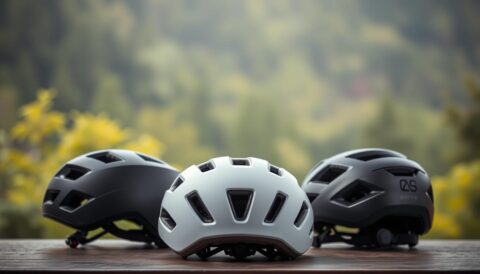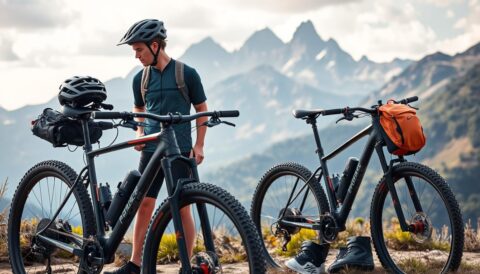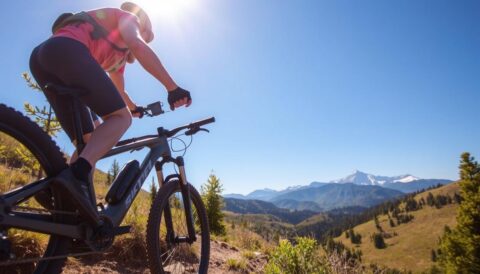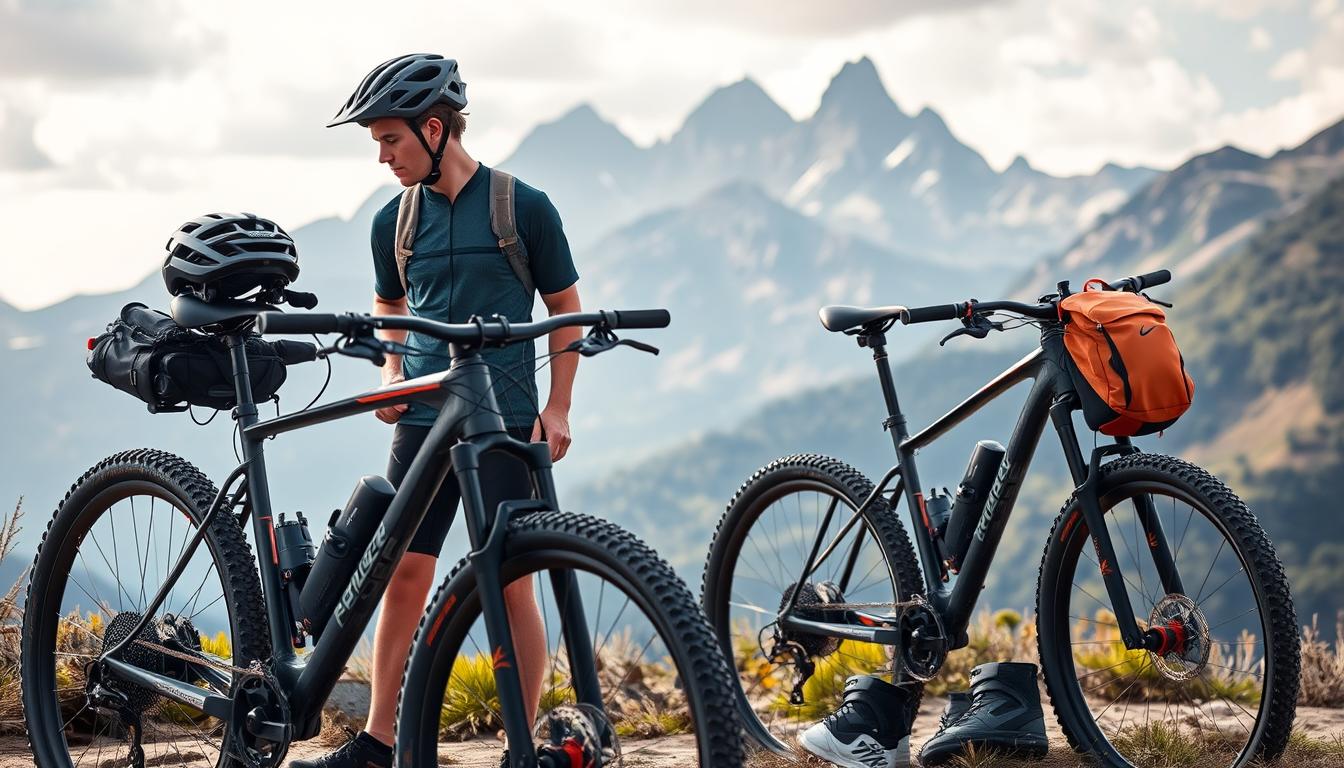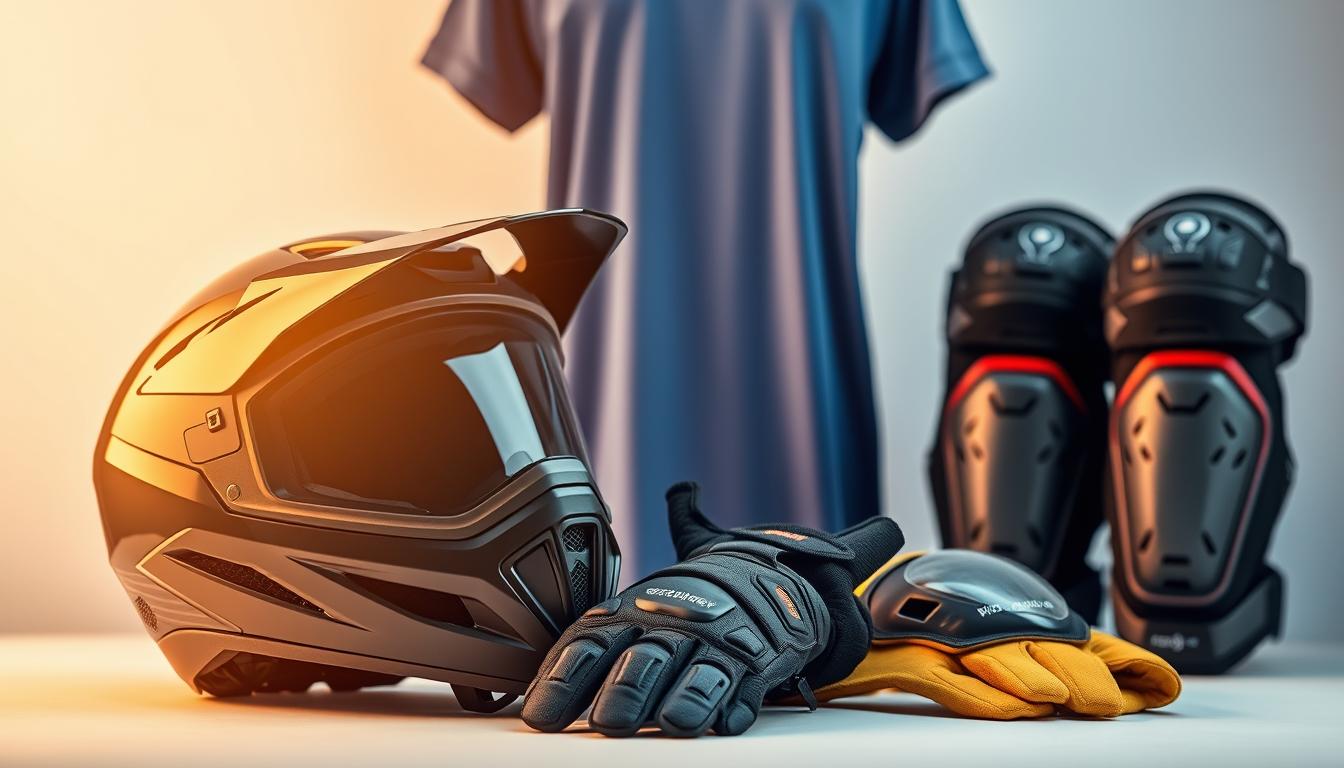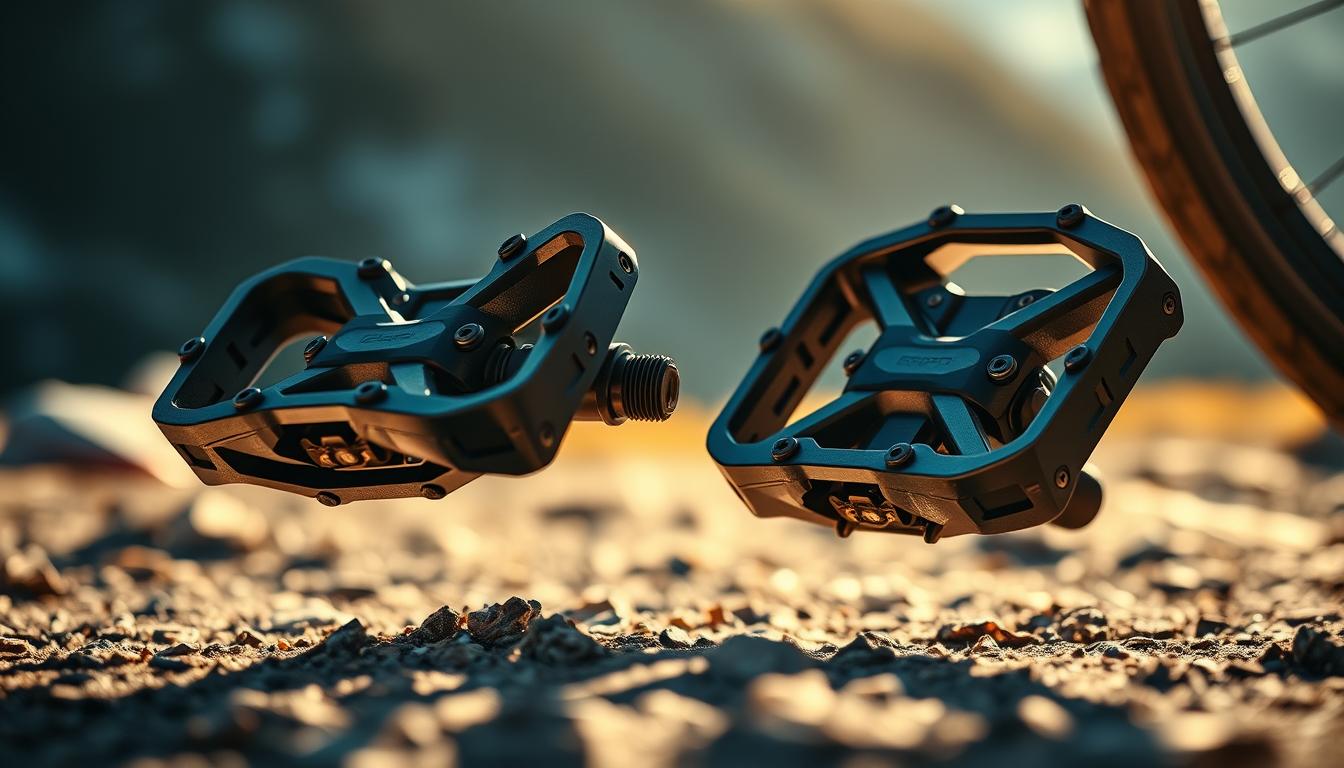Freeride mountain biking requires top-notch protection for riders tackling challenging terrains. Choosing the right helmet is vital for those who love extreme descents. Prices often reflect the importance of safety in this thrilling sport1.
Freeride helmet technology has made huge strides recently. Modern designs now offer advanced safety features beyond traditional protection2. These innovations aim to shield riders from potential impacts during intense rides.
Pro mountain bikers see high-quality helmets as essential gear, not just accessories. Top-rated helmets boast protection scores between 8.0 and 10.02. This ensures comprehensive safety during challenging mountain biking adventures.
Freeride helmet prices range from £70 to £2703. This variety allows riders to find helmets that meet both safety needs and budget constraints.
When choosing a helmet, focus on protection, comfort, and ventilation. Look for models with advanced impact protection systems. Seek out designs that boost safety without hindering performance2.
Understanding Mountain Bike Helmet Safety Features
Mountain bike helmets are vital for rider safety during intense freeride adventures. Advanced technologies protect cyclists from potential impacts. Knowing these features helps in choosing the right helmet4.
Multi-Directional Impact Protection System (MIPS)
MIPS technology reduces dangerous forces during angled crashes. It allows the helmet’s inner layer to rotate slightly upon impact. This innovative design helps disperse rotational energy, minimising brain injury risks5.
- Reduces rotational forces during impacts
- Provides additional brain protection
- Integrated into high-performance helmets
Dual-Density EPS Foam Technology
Dual-density EPS foam is a significant advancement in impact absorption. It combines different foam densities to manage various impact scenarios. This multi-layered approach ensures protection across low- and high-speed impacts6.
| Foam Density | Impact Protection |
|---|---|
| Low-Density Layer | Absorbs Low-Speed Impacts |
| High-Density Layer | Manages High-Speed Collisions |
Coverage and Shell Construction
Freeride mountain bike helmets offer extensive coverage for challenging terrain encounters. Shell materials distribute impact forces and maintain structural integrity. Choosing the right mountain bike helmet requires careful consideration of shell construction4.
“Protection is not an option, it’s a necessity in mountain biking.”
Modern helmet designs use advanced materials for lightweight performance. These materials also provide exceptional protective capabilities. Ensuring maximum safety during intense rides is crucial for mountain bikers.
Best Freeride Mountain Biking Helmets in 2024
The right freeride helmet can greatly improve your mountain biking experience. Our 2024 helmet review reveals top choices for riders seeking ultimate protection and performance7.
We’ve researched 50 helmets and found the best options for 2024. Here are the top contenders that stand out in the market:
- Fox Racing Speedframe Pro: The best overall helmet with impressive features
- Price: £190
- Weight: 380g (Medium)
- Vent channels: 19
- Rotational protection: MIPS technology7
- POC Kortal Race MIPS: Premium upgrade option
- Price: £250
- Weight: 400g (Medium/Large)
- Exceptional coverage design8
- Giro Manifest Spherical: Most comfortable choice
- Price: £260
- Weight: 346g (Medium)
- Advanced MIPS Spherical protection7
Safety meets style in these top-rated freeride helmets for 2024!
About 80% of these premium helmets have adjustable visors. Prices range from £190 to £260. All models meet CPSC and European EN1078 safety standards8.
These helmets feature advanced protection technologies like MIPS. MIPS allows the helmet to move during impacts, reducing potential head injury risks8.
Essential Features for Ventilation and Comfort
Mountain bike helmets balance safety, comfort, and performance. Proper airflow systems and helmet fit can greatly improve a rider’s experience. This is especially important during intense freeride adventures910.
Strategic Vent Placement
Helmet ventilation is crucial for mountain bikers. Different helmet types have various vent layouts based on riding style. Cross-country helmets have many ventilation holes for maximum airflow.
Trail and downhill helmets use strategically placed vents. This design maintains protection while allowing some air circulation9.
- Cross-country helmets: Maximum ventilation
- Trail helmets: Balanced protection and airflow
- Downhill helmets: Minimal vents, maximum safety
Adjustable Retention Systems
Modern mountain bike helmets have advanced adjustable retention systems. These ensure a secure and comfortable fit. Riders can customise helmet positioning, reducing movement and improving safety10.
| Helmet Type | Size Range | Weight Range |
|---|---|---|
| Half-shell | 55-59 cm | 350-515 grams |
Moisture Management
Effective sweat-wicking technologies are vital for comfort during challenging rides. Quality helmets have moisture control features. These help keep riders cool and focused10.
“The right helmet is not just about protection, but about creating an optimal riding experience.”
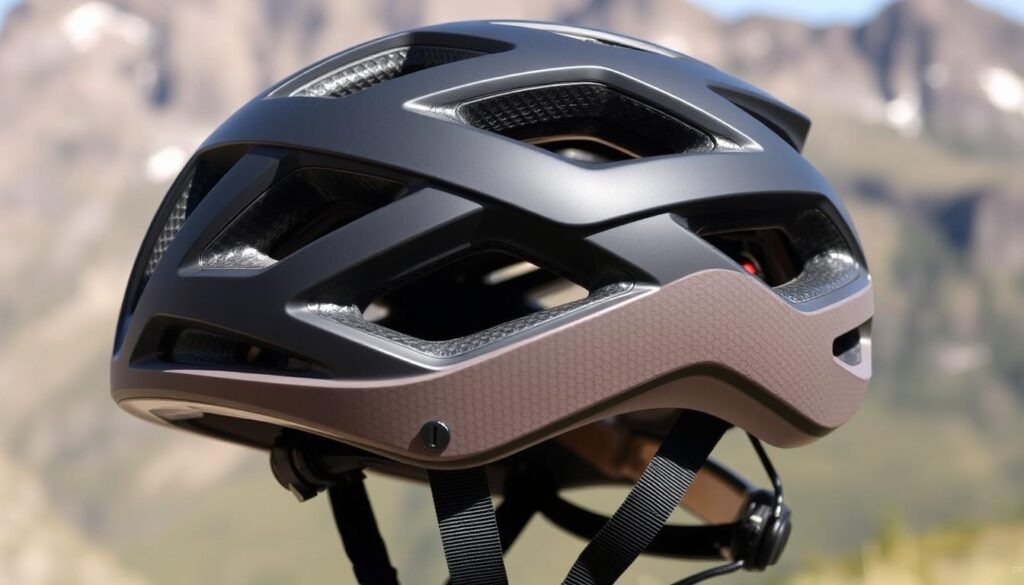
Choose a freeride mountain bike helmet with advanced airflow systems. Look for adjustable fit mechanisms and excellent moisture management. These features ensure top comfort and performance910.
Price Range and Value Considerations
Freeride mountain biking helmets come in various price ranges. From budget-friendly to premium choices, there’s something for everyone11. The value depends on safety features, protection level, and overall performance.
- Entry-level helmets: £100-£150 range
- Mid-range helmets: £150-£250 range
- Professional-grade helmets: £250-£350 range12
When assessing helmet pricing, riders should consider several key factors. These include safety technologies, ventilation system effectiveness, fit and comfort features.
Durability and materials also play a crucial role in determining a helmet’s value for money.
- Safety technologies like MIPS
- Ventilation system effectiveness
- Fit and comfort features
- Durability and materials
| Helmet Category | Price Range | Key Features |
|---|---|---|
| Traditional Half-Shell | £100-£200 | Basic protection, lightweight design |
| Advanced MIPS Helmets | £200-£300 | Enhanced rotational impact protection11 |
| Full-Face Performance | £300-£400 | Maximum protection, professional-grade features13 |
Pro tip: Invest in the best helmet your budget allows, prioritising safety and comfort over cost savings.
“Your head is worth more than any price tag – choose wisely!” – Mountain Biking Safety Expert
Conclusion
Choosing the right freeride mountain bike helmet is crucial for rider safety. Prioritise helmets with MIPS and advanced shell constructions. Prices range from £290 to £440, catering to various budgets and safety needs1415.
Modern helmets boast strategic ventilation, adjustable fit systems, and advanced impact-absorption technologies. Top-tier helmets offer exceptional protection while remaining comfortable and lightweight15.
Familiarise yourself with certification standards like ASTM F1952, CPSC 1203, and EN1078. These ensure comprehensive protection during intense mountain biking14. For in-depth information, consult professional helmet comparisons.
Your helmet is your most crucial safety gear. Opt for quality, fit, and advanced protective technologies. This approach ensures confidence and peace of mind while enjoying freeride mountain biking.
FAQ
What makes a helmet specifically suitable for freeride mountain biking?
Freeride mountain biking helmets offer enhanced protection and extended head coverage. They feature advanced impact absorption technologies like MIPS and robust ventilation systems. The superior shell construction withstands extreme terrain and potential crash scenarios.
How does MIPS technology improve helmet safety?
MIPS reduces rotational forces during angled impacts. It allows slight movement between the helmet’s inner and outer shells. This additional layer helps minimise potential brain injuries by dissipating rotational energy during crashes.
Why are dual-density EPS foam helmets recommended for freeride mountain biking?
Dual-density EPS foam provides variable impact protection across different helmet areas. Softer foam sections absorb low-speed impacts. Denser regions manage high-energy collisions, offering comprehensive protection for diverse riding conditions.
How important is proper helmet ventilation for freeride mountain biking?
Effective ventilation is crucial for temperature regulation and rider comfort during intense rides. Strategic vent placement helps manage heat and reduces sweat accumulation. This prevents discomfort when navigating challenging and physically demanding freeride trails.
What should I consider when selecting a freeride mountain bike helmet?
Consider safety certification, MIPS technology, and shell coverage. Look for impact protection, ventilation systems, and weight. Check fit adjustment mechanisms and moisture-wicking properties.
Ensure compatibility with additional protective gear like goggles or neck braces.
How much should I expect to spend on a quality freeride mountain bike helmet?
Quality freeride helmets typically range from £150 to £350. Higher-end models offer advanced safety features and superior materials. Prioritise protection and safety over budget when selecting a helmet.
How often should I replace my freeride mountain bike helmet?
Replace your helmet every 3-5 years or after a significant impact. Protective materials can degrade over time, even without visible damage. This may compromise the helmet’s ability to protect you during a crash.
Are full-face helmets necessary for freeride mountain biking?
Full-face helmets provide superior protection for high-risk terrain and aggressive downhill riding. They cover the entire face and jaw. These helmets are recommended for technical trails, big mountain descents, and advanced manoeuvres.
Source Links
- Switchback Travel | Best Mountain Bike Helmets of 2024
- The 10 Best Mountain Bike Helmets
- Best mountain bike helmets in 2025 | Top-rated open-face trail helmets
- The safety bible – Everything you need to know about bike helmets and protectors
- MTB Helmet Guide
- Best Full Face Mountain Bike Helmet Review – Gear Hacker
- 4 Best MTB Helmets of 2024 (Tested & Reviewed)
- The Best Mountain Bike Helmets, Trail Tested
- How to Choose a Mountain Bike Helmet
- How to Choose a Mountain Bike Helmet – GearLab
- The ULTIMATE GUIDE TO BUYING MTB HELMETS | Written by industry pros
- 7 of the Best Lightweight Full Face Helmets | Vital MTB Roundup
- Best mountain bike helmets reviewed and rated by experts – MBR
- 9 of the Best Full Face Helmets | Vital MTB Roundup
- Lightweight, baby! – 9 lightweight and convertible full-face mountain bike helmets in review

